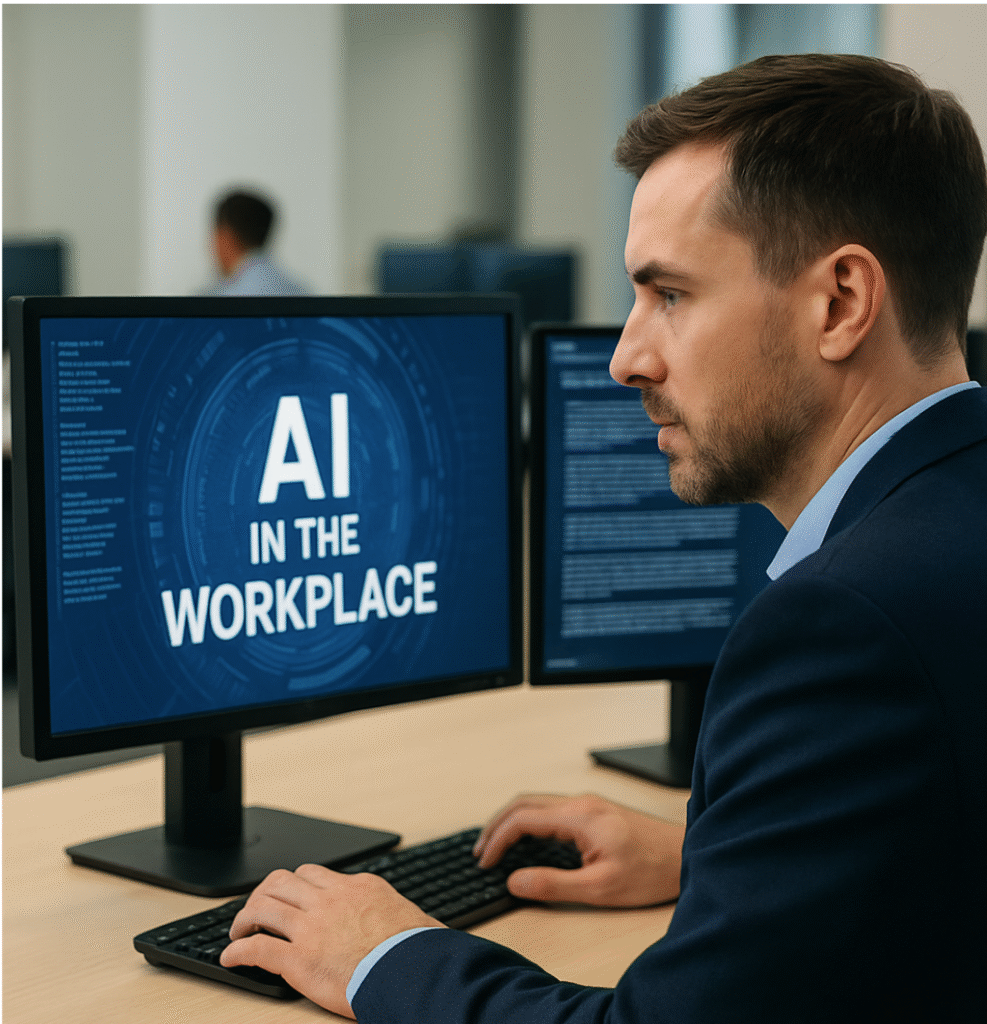As businesses across the globe race to adopt artificial intelligence (AI), a new era of workplace transformation is unfolding—one that promises unprecedented productivity gains but also raises serious questions about job displacement, ethics, and regulation.
From automating routine tasks to making strategic business decisions, AI is no longer a tool of the future—it is the defining force of the present. In 2025, companies large and small are embedding AI into every layer of operations, fundamentally altering how—and by whom—work gets done.
A New Wave of Automation
In industries ranging from finance and logistics to healthcare and customer service, AI systems have become integral. According to a recent report by the World Economic Forum, over 80% of global companies are now using some form of AI in daily operations, with generative AI—technologies like ChatGPT and Claude—leading the charge.
“AI isn’t just replacing tasks anymore,” says Dr. Amina Roy, a labor economist at MIT. “It’s reshaping roles, augmenting decision-making, and even taking on creative functions once thought to be uniquely human.”
Take, for example, the legal sector. In 2023, global law firm Allen & Overy integrated an AI tool to draft legal contracts. By 2025, the firm reports a 40% reduction in time spent on routine documentation. Similar trends are being seen in journalism, design, and even software engineering.
AI and Employment: A Double-Edged Sword
While AI improves efficiency and cuts costs, it also sparks concern over employment. A recent McKinsey & Company analysis predicts that 12 million jobs in the U.S. alone could be affected by AI by 2030, with clerical, customer support, and administrative roles being the most vulnerable.
But it’s not all bad news. McKinsey’s same report notes that new roles will emerge, particularly in AI oversight, prompt engineering, data ethics, and human-AI collaboration. Companies are shifting hiring efforts to roles that complement, rather than compete with, machine intelligence.
“Every industrial revolution has brought disruption—but also opportunity,” says Roy. “The key difference now is the speed. We must adapt faster than ever before.”
Upskilling and Reskilling: The Corporate Imperative
In response to these rapid changes, corporations are investing heavily in employee reskilling programs. Tech giant IBM announced earlier this year that it would invest $1 billion over the next five years to train its workforce in AI-related disciplines. Similarly, Amazon has expanded its internal AI bootcamps and offers certifications in machine learning to all employees.
Public initiatives are also underway. In the U.K., the government launched the Future Skills Fund, a £2 billion investment targeting digital literacy and AI competency training for mid-career workers. In the U.S., states like California and Texas are piloting free AI courses in community colleges to help bridge the skills gap.
“The jobs aren’t disappearing—they’re evolving,” says Rachel Tan, director of workforce development at Coursera. “But if we don’t equip people with the tools to evolve too, we risk deepening inequality.”
AI and Ethics: An Unsettled Debate
With AI’s rise comes an avalanche of ethical dilemmas. Bias in machine learning models, lack of transparency, surveillance concerns, and the potential misuse of deepfakes are pressing issues that regulators and companies alike are scrambling to address.
The European Union’s AI Act, passed earlier this year, sets the world’s first comprehensive legal framework for AI systems. It bans certain applications outright—such as AI-powered social scoring—and imposes strict transparency requirements on “high-risk” systems.
In the U.S., regulation remains fragmented. Federal lawmakers are pushing for a national AI framework, but progress is slow. Meanwhile, states like California and New York have introduced their own rules around AI usage in hiring and data collection.
“AI must be aligned with human values,” says Maya Dasgupta, a policy analyst at the Center for Humane Technology. “Without robust governance, we risk letting profit dictate outcomes that affect all of society.”
The AI Divide: Global Disparities
While AI adoption soars in developed economies, many developing nations are struggling to keep pace. Limited access to data infrastructure, lack of skilled talent, and economic inequality threaten to widen the digital divide.
A report from UNESCO warns that unless urgent measures are taken, the global AI revolution could leave behind over 2 billion people who lack access to the internet or digital education.
To combat this, international organizations are stepping in. The World Bank recently launched the AI for All Initiative, which aims to fund AI education and infrastructure projects in low-income countries. Tech companies are also playing a role; Microsoft has pledged free AI training for 10 million learners in underserved regions by 2027.
AI in the Public Sector
Governments are not just regulators—they’re users too. AI is being employed in public health monitoring, fraud detection, traffic management, and citizen services.
In Singapore, the government’s Smart Nation initiative uses AI to optimize energy usage and streamline public services. In Estonia, AI helps process tax filings and manage national health records.
“These aren’t just efficiencies—they’re life-changing improvements,” says Tanvi Mehta, an AI strategist at the UN. “But transparency and accountability must be built into every algorithm used by governments.”
Voices from the Workforce
Despite macro-level trends, the impact of AI is deeply personal for workers on the ground.
“I used to spend half my day responding to customer queries manually,” says Peter Nguyen, a customer service representative at a major telecom firm. “Now an AI handles the basics, and I focus on more complex cases. It’s made my job more interesting—but also more demanding.”
For others, the adjustment has been more difficult.
“My position was eliminated after a chatbot replaced our front desk system,” shares Leila Martin, a former receptionist. “I’m retraining in digital marketing now, but it’s scary how fast things changed.”
The Road Ahead
AI’s rapid integration into the workplace is reshaping the global labor market faster than any previous technological shift. It brings with it the promise of prosperity and innovation—but also the peril of disruption and inequality.
Governments, companies, and individuals alike face a pivotal moment. Choices made now—in education, ethics, and policy—will determine whether the AI revolution becomes a force for inclusion and empowerment, or a catalyst for division.
As Roy concludes, “AI is not destiny. It’s a tool. What we do with it—how we share its benefits, minimize its risks, and prepare people for its impact—will define the future of work for generations to come.”


